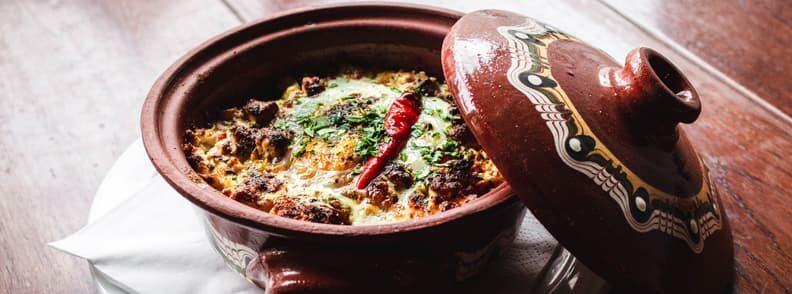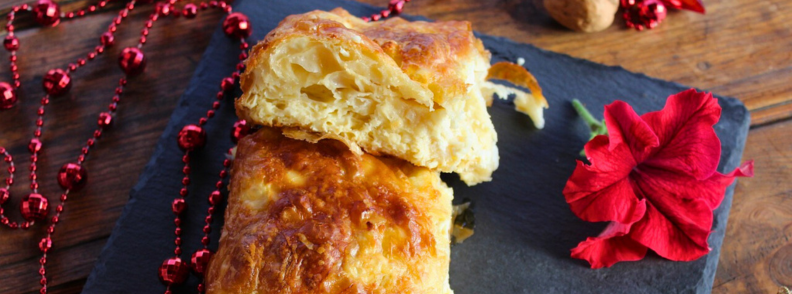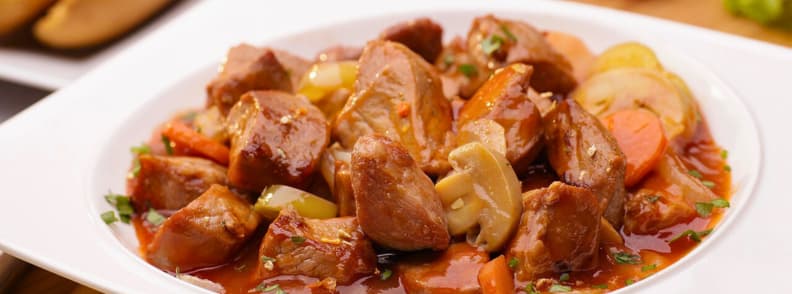Today we’ll cover the top 10 things to eat and drink in Bulgaria when you’re traveling through the Balkans. But first, let me introduce you to Bulgarian cuisine.
Bulgarian cuisine is part of Southeast Europe’s Mediterranean cuisine and it’s very similar to other Balkan cuisines.
Bulgarian cuisine is a diverse and delectable fusion of regional influences and the nation’s own distinctive traditions. It is renowned for its substantial meals that are filling and created with flavorful spices and fresh ingredients.
An entrée to traditional Bulgarian cuisine
Salads are frequently used as starters in Bulgarian cuisine, along with a variety of soups such as cold tarator soup and pastries like banitsa, pita, and the ever-present börek. Other well-known Bulgarian recipes include kavarma, a stew prepared with meat, vegetables, and white wine, and shkembe chorba, a fiery tripe soup cooked with vinegar and garlic.
Mutton, pork, and poultry are among the variety of meats that are popularly grilled or roasted over an open fire in Bulgaria. A variety of fresh salads and vegetables, such as tomatoes, cucumbers, and peppers, are frequently offered with Bulgarian meals.
Bulgarian cuisine offers a range of sweet delicacies in addition to its savory dishes. These include baklava, a flaky pastry filled with honey and almonds, and kozunak, a sweet bread typically eaten around Easter.
In addition, Bulgarians are renowned for their rakia, lovely wines, and dairy products. You should give the local beer a try – you’ll be pleased!

Is it cheap to eat and drink in Bulgaria?
Yes, when it comes to food and drink, Bulgaria is renowned for being a wallet-friendly vacation. Because Bulgaria’s cost of living is relatively cheap, locals and visitors from other countries may take advantage of the country’s reasonable costs for food, groceries, and beverages. This is particularly true if you choose to dine at neighborhood eateries and markets as opposed to tourist attractions, which could charge more.
Additionally, Bulgaria is famed for its delectable and reasonably priced local cuisine, so while you’re there, be sure to sample some of the local specialties.
What is Bulgaria’s most famous food?
The most well-known dish in Bulgaria is lyutenitsa. Actually formed from roasted red peppers, eggplant, and tomatoes, it is a versatile and mouthwatering traditional Bulgarian condiment.
It is a thick sauce that can be spread and is frequently used as a garnish for grilled meats like kebapcheta and kyufteta. Additionally, lyutenitsa can be used as a filler for banitsa or as a dip for bread.
The peppers, eggplant, and tomatoes are roasted until they are fork-tender and just beginning to caramelize before being combined with the garlic, seasonings, and olive oil to make the sauce. The outcome is a thick, delicious sauce with a sweet, somewhat spicy flavor.
What do they eat in Bulgaria?

1. Banitsa
A typical Bulgarian dish called banitsa is formed of phyllo dough and filled with an egg and cheese combination. The filling is piled on top of the dough, which is then wrapped up and cooked until golden.
In Bulgaria, this sweet pastry delight is a well-liked breakfast item, however, it may also be enjoyed as a snack or a light meal at any time of the day. Yogurt is frequently offered on the side to help offset the richness of the cheese and eggs.
Several savory contents, such as feta cheese, sirene (a type of white cheese), spinach, mushrooms, or cabbage, can be used to make banitsa. It can also include sweet fillings like walnuts, apples, or pumpkins.
It is a wonderful and filling dish to eat in Bulgaria, perfect for backpackers on the road as street food.

2. Tarator soup
Similar to the Spanish Gazpacho, Tarator is a cool, light meal that is frequently served cold and is a go-to during the sweltering summer. It is a traditional Bulgarian soup prepared with yogurt, cucumbers, and dill. To put it another way, it’s a more liquid form of the Greek Tzatziki.
In order to get this Bulgarian soup’s smooth and creamy texture, yogurt, cucumbers that have been grated, water, garlic, dill, and other ingredients are blended together. After that, it is served chilled with more dill as a garnish and maybe a drizzle of olive oil. However, you may also add walnuts and ice cubes to this soup to make it even cooler on scorching summer days.
A small lunch or as an appetizer for a bigger dinner, tarator is a nutritious and filling soup.
3. Shkembe chorba
The stomach lining of a cow or a sheep is used to make the traditional Bulgarian dish shkembe chorba – also referred to as tripe soup. It’s a delicious, spicy soup that is frequently accompanied by a side of vinegar and hot peppers for extra spice.
Shkembe chorba, a traditional meal that is now famous in Bulgaria, is thought to have originated in the Ottoman Empire when it was a favorite of the underprivileged who could not afford to consume more costly cuts of beef. It’s currently regarded as a delicacy in Bulgaria and frequently offered during festive events.
Tripe is cooked in the soup by boiling it until it is soft, at which point onions, garlic, tomatoes, and various spices are added to make a rich and fragrant broth. It’s a filling and substantial dish that will definitely keep you warm on a chilly day.

4. Shopska salad
Traditional Bulgarian food known as shopska salad is created with a variety of fresh vegetables such as tomatoes, cucumbers, onions, and peppers. It is often served as a side dish or a light dinner and topped with crumbled feta cheese and a drizzle of olive oil.
The name of this salad comes from the reputed birthplace of the dish, the Shoppe region of Bulgaria. The Shopska salad, a mainstay of Bulgarian cuisine, is reviving and light in flavor, making it the ideal companion to grilled meats and other heavy meals.
When visiting Bulgaria, you will see this salad on every menu. The Shopska salad is straightforward and made with simple components, in the colors featured on the Bulgarian flag.
Simply cut the veggies and combine them in a big dish to make a Shopska salad. Olive oil should be drizzled over the dish before adding the crumbled feta cheese. Salt and pepper should then be added to taste. Enjoy the flavorful blending of tastes and textures by serving the salad cold or at room temperature.

5. Kavarma
Traditional Bulgarian stew known as kavarma is cooked with a combination of meat, vegetables, and spices. Depending on the location and the cook’s personal tastes, the ingredients and cooking techniques change, but the standard recipe calls for a combination of meat (pig, beef, or chicken), vegetables (onions, carrots, peppers, etc.), and spices (paprika, cumin, black pepper, etc.).
In a saucepan or casserole dish, the ingredients are boiled together until the meat is soft and the veggies are fully cooked. Ask ahead of time or pass if you don’t like spicy cuisine because the flavor might be moderate or scorching.
In addition to being frequently served with rice or bread on the side, kavarma is a filling and substantial dish that is ideal for a chilly day. As the stew simmer, the flavors deepen and amplify, creating a wonderful and rich dish that is sure to become a family favorite when you eat in Bulgaria.
6. Kebapcheta / kyufte
Traditional Bulgarian fare called kebapcheta, often written kebabcheta or kyufte, consists of grilled ground pork sausages.
Typically, onions, spices, and herbs are used with minced pig or beef to make these specific Bulgarian sausages. They are cut into little sausage-like forms and grilled over an open flame until they are thoroughly cooked and have a crispy exterior.
When served as a main course, kebapcheta frequently has rice, vegetables, or a salad on the side. It can also be offered as an appetizer or snack, frequently with a dipping sauce such as yogurt or ajvar (a roasted red pepper sauce).
7. Kyufteta
Traditional Bulgarian cuisine known as kyufteta, often written kjufte or kjuletsa, consists of grilled meatballs.
Typically, onions, spices, and herbs are added to ground beef or pig to create these Bulgarian meatballs. They are formed into little balls and grilled over an open flame until they are thoroughly cooked and have a crispy exterior.
The same sides may be served with kyufteta, just like they can with the kebapcheta above, whether it is as a main meal, a snack, or an appetizer.

8. Sarmi
Another classic Bulgarian meal made of packed grape leaves is sarma. Usually, rice, minced meat, and spices are mixed with the grape leaves before being packed, folded into little packets, and steamed or baked until cooked.
The Bulgarian sarma can be served as a beginning or an appetizer, with a side of vegetables or a salad. Many people in Bulgaria and elsewhere like this tasty and filling dish that is made from the tastes of the stuffing and the grape leaves.
Sarmi is a flexible and practical alternative for any meal because it is frequently prepared in large amounts and may be eaten hot or cold.

9. Börek
Börek is a sort of savory pastry that is popular around the world, particularly in the Balkans, the Middle East, and Central Asia. It is sometimes referred to as burek or borek. The filling is rolled or stacked onto phyllo dough, which is then cooked until golden and crunchy.
The filling might vary based on the location and the individual, but meat, cheese, veggies, or a mix of these components are frequently used.
A popular supper or snack, borek is frequently served with yogurt or tea. It’s a delectable and filling traditional Bulgarian dish that is loved by plenty of people all around the world.
10. Kiselo mlyako
Kiselo mlyako is a sort of sour milk that is popular in Bulgaria and other Balkan countries. It’s also called kiselo mlijeko or kiselo vrhnje. This Bulgarian sour milk is produced by fermenting milk with lactic acid and bacteria, which gives the finished product a tart and sour taste.
Banitsa and tarator soup are only a few of the recipes that frequently include Bulgarian kiselo mlyako as a condiment or ingredient. It’s also frequently drunk by itself as a cool and healthful beverage.
A cornerstone of Bulgarian cuisine, kiselo mlyako is high in probiotics, which are good for intestinal health.
What not to eat in Bulgaria
In Bulgaria, the culinary scene is rich and diverse, offering a plethora of traditional dishes that are deeply rooted in the country’s history and culture. However, when traveling to Bulgaria, there are a few general precautions to consider:
- Tap water. While tap water in Bulgaria is generally considered safe to drink, it’s always a good precaution to opt for bottled mineral water, especially if you have a sensitive stomach. This helps in avoiding any potential stomach upsets.
- Food hygiene. Bulgaria maintains good hygiene standards, but like any other travel destination, it’s essential to be cautious. Avoid consuming food that looks old or appears not to have been cooked thoroughly, especially when it comes to meat and fish.
- Street food. While street food can be a delightful experience, always ensure that the food is freshly prepared in front of you and that the vendor maintains clean practices.
Remember, these are general guidelines and not specific foods to avoid. Bulgarian cuisine is delicious and offers a range of dishes from salads, soups, pastry, to grilled meats and fish. Always trust your instincts and enjoy the culinary journey!

What do they drink in Bulgaria?
Many people in Bulgaria prefer drinking domestic wines, which is why the nation has a growing wine sector. This Balkan nation has several wine-producing regions and makes a huge selection of red, white, and rosé wines. Bulgarian wines are renowned for their deep, nuanced tastes and are frequently produced using local grapes like Mavrud, Melnik, and Pamid.
In addition to wine, rakia (40–90% alcohol) is a popular beverage in Bulgaria. This fruit brandy is produced by distilling the fermented juice of grapes, plums, pears, apples, apricots, cherries, or figs. Rakia is frequently used as an aperitif or digestif and is frequently accompanied by grilled meats or meze (small appetizers).
Bulgarians also enjoy beer, tea, and coffee.
Bonus:

How do you say cheers in Bulgarian when drinking?
In Bulgarian, the most frequent way to express cheers after drinking is Nazdrave! (pronounced nahz-DRAH-ve). This statement is used to wish someone well and to salute a particular event. It’s used similarly to the English proclamation Cheers! to raise a glass and toast with friends and loved ones.
Another way to express cheers in Bulgarian is Za vas, which means for you, and Za zdrave, which means for health (pronounced zah z-DRAH-ve).
In conclusion, Bulgarian cuisine and drink offer a delectable and fulfilling fusion of tastes and customs that has something to please everyone. Whether you’re craving grilled meats, delicious sweets, or substantial stews, accompanied by good wine, you’ll easily find something to eat and drink in Bulgaria that’s catered to your taste!

Mirela Letailleur, nestled in the picturesque South of France, is a seasoned Romanian travel aficionado with a keen eye for the hidden gems of Europe. Through her platform, The Travel Bunny, she delves deep into the heart of affordable European adventures, offering readers unparalleled insights and bespoke travel guides. A testament to her expertise is her profound knowledge of Bulgarian cuisine, making her the go-to authority for those eager to explore the best of Bulgarian food and drink.
Whether you’re curious about the staples Bulgarians relish daily or seeking the finest local beverages, Mirela’s comprehensive guides ensure you savor the authentic taste of Bulgaria. Beyond her culinary prowess, she’s a problem solver at heart and a budding coffee connoisseur, always ready to brew the perfect cup.
After finding what to eat and drink in Bulgaria, you should also read
Traditional Greek food and drinks you must try
Most beautiful places to visit on Bulgaria’s seaside (with map)
Top things to do in Balchik, Bulgaria

